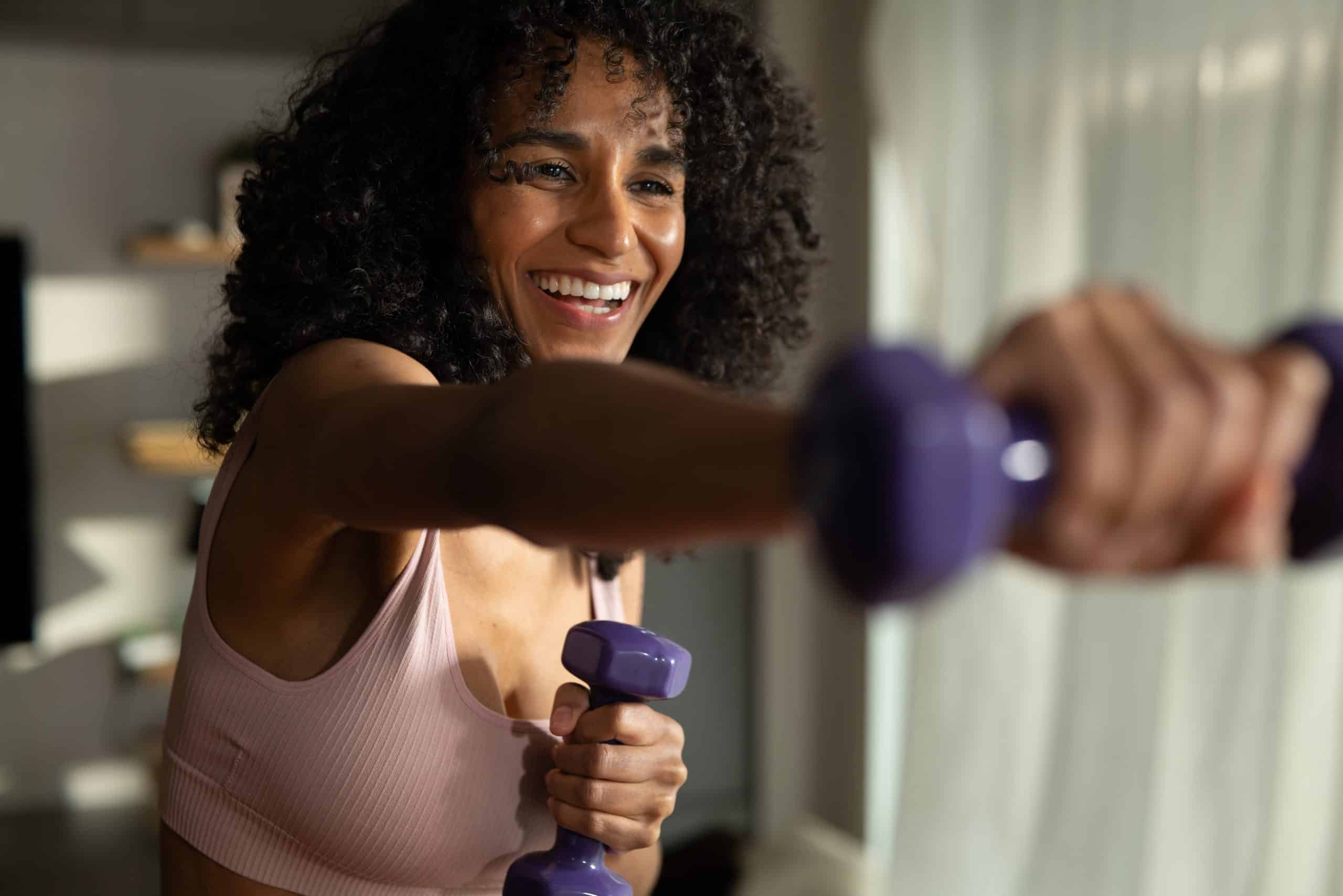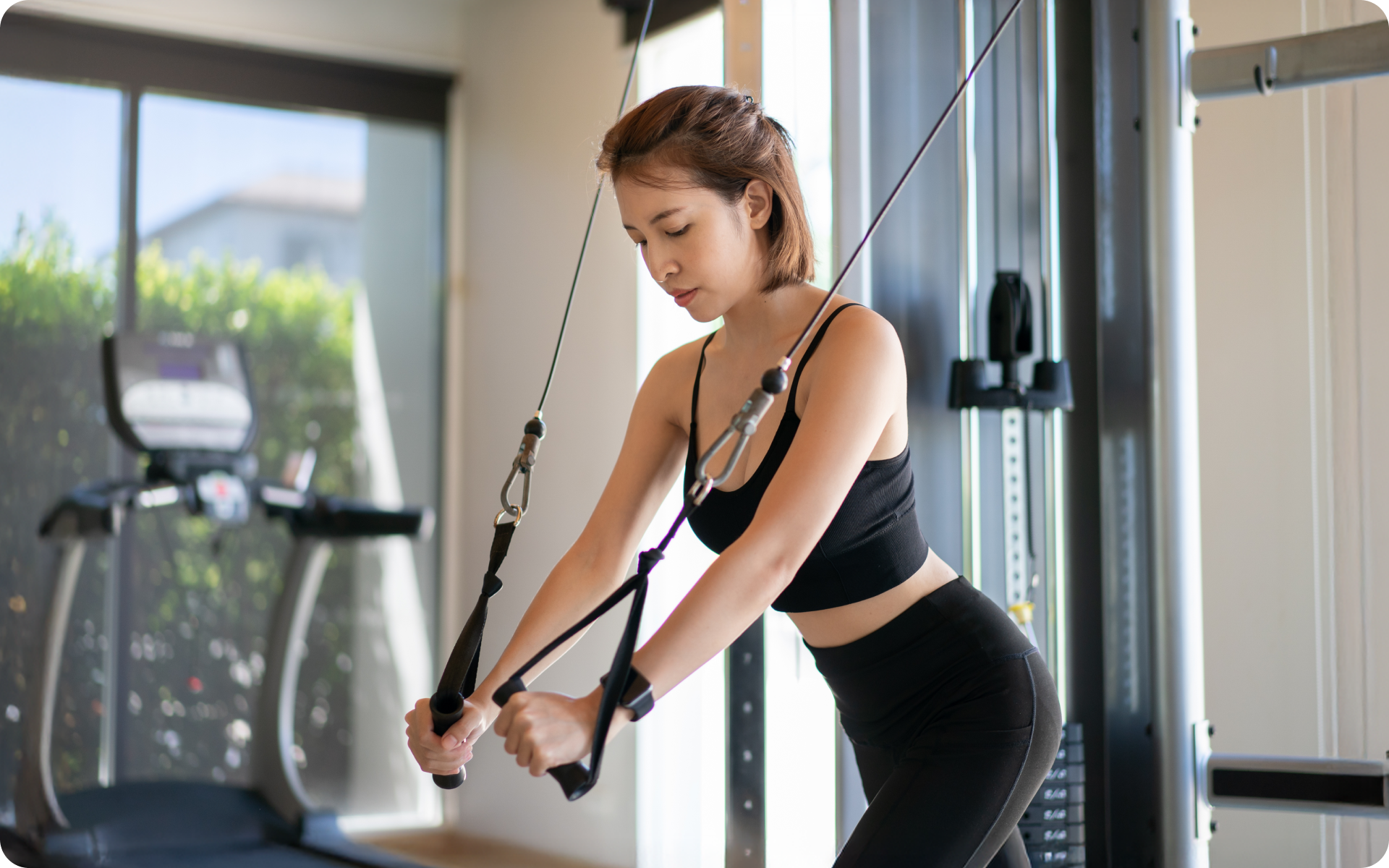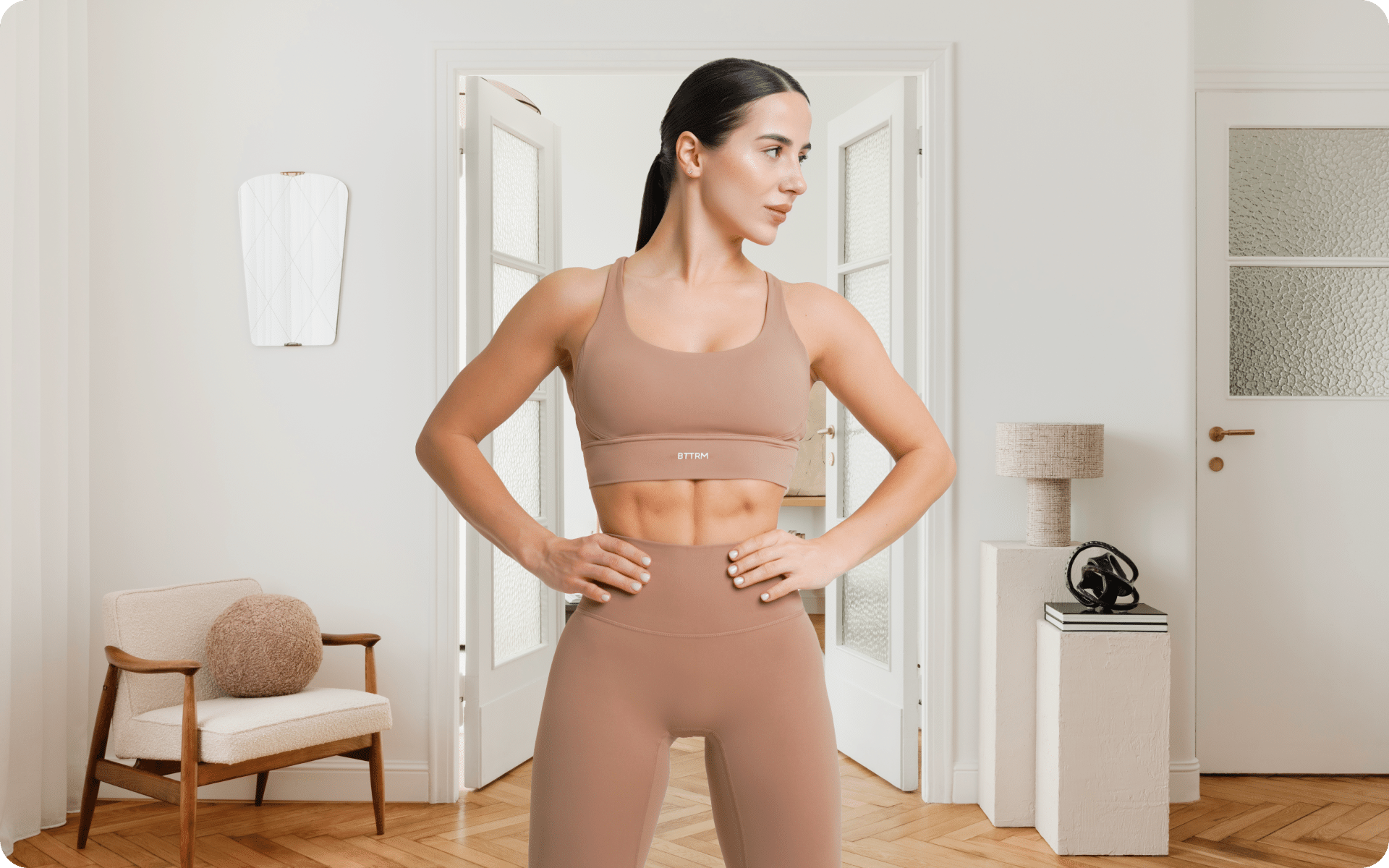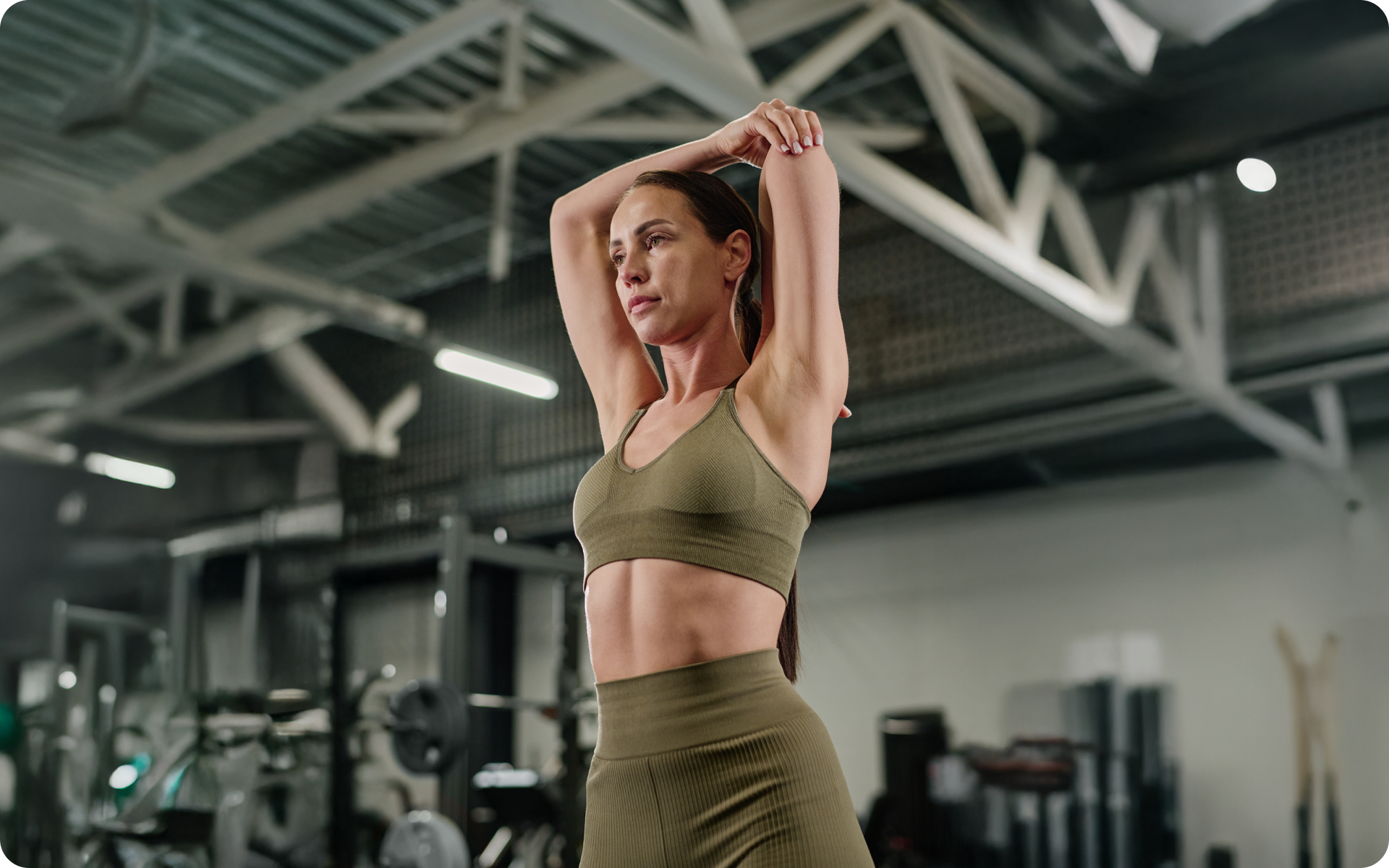Strong shoulders help with everyday activities, enhance performance in a variety of sports, and can even reduce the risk of injuries by supporting joint stability. Plus, aesthetically, well-defined shoulders can significantly improve the appearance of your upper body, giving it a broader and more balanced look.
Using dumbbells for shoulder exercises is particularly effective.
They’re handy, since you can easily adjust the weight to fit your strength level, and they promote a greater range of motion, compared to other types of equipment.
Dumbbells also encourage muscle balance and coordination by forcing each side of your body to pull its own weight.
Here are 6 of the best dumbbell exercises to add muscle definition, strength, and endurance to your shoulders.
Can You Build Shoulders with Dumbbells?
Yes; dumbbell workouts are effective in building your shoulder muscles. Here are a few reasons why:
Provide Resistance
Resistance refers to the amount of weight you have to move during an exercise. While body weight workouts may be a good starting point for most people, eventually, many need to increase the resistance for continued progress (5).
Dumbbells, like other resistance training equipment, are one way to do that.
With dumbbells, you can add weight in small increments, making it easier for you to progress gradually at your own pace.
Enhance Range of Motion
Dumbbell exercises promote a larger range of motion, compared to machines. Range of motion refers to the distance a joint is capable of moving (4).
By using dumbbells, you’re able to stretch and contract your muscles through a greater range of motion, improving flexibility, mobility, and functional strength in your shoulders. When compared to most resistance training machines, which often include a predetermined track of motion, as well as barbells, which are an excellent form of free weight strength training but are limited to primarily bilateral movement patterns, dumbbells allow for an essentially unrestricted plane of motion in every direction.
Lean and toned up body isn’t just a far-fetched fantasy. Check out the BetterMe app and watch it propel your weight loss journey into high gear!
Promote Muscle Balance
When using machines for workouts, it’s easy for one side of your body to compensate for the other, leading to muscle imbalances. This can result in injuries and hinder your progress.
With dumbbells, each side of your body must work independently, promoting muscle balance and coordination (3).
Target Specific Muscles
Dumbbells allow you to target specific muscles in your shoulders, such as the deltoids and rotator cuff. This allows for more focused and effective training that can help add definition and strength to your shoulder muscles.
Below is a list of all the major and minor muscles in the shoulder area, their functions and how they are targeted with dumbbell exercises:
The shoulder area is a complex network of muscles and tendons that provide a wide range of motion to the arm. Understanding the anatomy and function of these muscles is crucial for effective training and injury prevention.
Here’s a comprehensive overview of the major and minor muscles in the shoulder area, their functions, and how they can be targeted with dumbbell exercises.
Deltoids
The deltoids have three distinct segments (anterior, middle, and posterior) that are responsible for enabling movements like arm elevation, rotation, and stabilization.
Dumbbell exercises that target the deltoids:
- Anterior Deltoids: Front Raises, Arnold Press
- Middle Deltoids: Lateral Raises, Seated Overhead Press
- Posterior Deltoids: Bent-Over Reverse Flies, Face Pulls
Rotator Cuff Muscles
Comprising four muscles (supraspinatus, infraspinatus, teres minor, and subscapularis), the rotator cuff stabilizes the shoulder joint and assists in various arm movements.
Dumbbell exercises that target the rotator cuff muscles: Internal and External Rotations, Lying External Rotation, Cuban Press
Read more: The Ultimate Chest Workout With Dumbbells Guide (FAQs Included)
Trapezius
The trapezius muscle extends along the neck and upper back, supporting the movement and stabilization of the scapula (shoulder blade).
Dumbbell exercises that target the trapezius: Shrugs, Upright Rows
Rhomboids
Positioned between the spine and the scapulae, rhomboids play a crucial role in retracting and elevating the scapula.
Dumbbell exercises that target the rhomboids: Bent-Over Rows, Reverse Flyes
Levator Scapulae
This muscle aids in the elevation of the scapula and the extension of the neck.
Dumbbell exercises that target the levator scapulae: Shrug variations focusing on the upper portion of the traps and neck.
Serratus Anterior
Known for its role in protracting the scapula, this muscle helps to rotate and move the scapula forward and up.
Dumbbell exercises that target the serratus anterior: Overhead Presses, Scapular Push-ups (bodyweight exercise)
Pectoralis Major
Though primarily a chest muscle, the pectoralis major assists in the flexion, adduction, and internal rotation of the humerus.
Dumbbell exercises that target the pectoralis major: Chest Press, Incline Press (targets the clavicular head, which impacts shoulder function)
Versatility
Dumbbells offer a wide range of exercises that can target all areas of your shoulder muscles. You can perform them standing, seated, or lying down on a bench, adding variety and challenge to your workouts. Plus, dumbbells can be easily incorporated into other exercises, such as lunges or squats, to add an extra challenge and target multiple muscle groups simultaneously.
Convenience
One of the biggest advantages of dumbbell workouts is their convenience. They take up minimal space, making them easy to store at home or in a gym. They’re also portable, allowing you to take your workout with you wherever you go. This makes it easier to stay consistent with your shoulder workouts and maintain progress.
Safety
Working with dumbbells can be safer, compared to other workout equipment, such as barbells or machines. Dumbbells allow for more natural movements and give you more control over the weight being lifted, reducing the risk of injury.
Since you’re not using a machine, there’s no fixed range of motion, allowing your body to move in a way that feels comfortable and safe for you.
Find out how you can work your shoulders at home in our calisthenics shoulder exercises article
What is the Most Comprehensive Shoulder Exercise?
The overhead press is one of the top exercises for developing strong and defined shoulders. It’s classed as a compound exercise, meaning it targets multiple muscle groups at once.
The main muscle groups worked during an overhead press with dumbbells are the deltoids, triceps, and upper chest. Additionally, it also activates smaller muscles in the shoulder area for stabilization.
To perform this exercise correctly:
- Stand or sit with your feet shoulder-width apart and hold a dumbbell in each hand at shoulder height.
- Press the weights up over your head until your arms are fully extended.
- Slowly lower the weights back to the starting position, keeping your elbows slightly bent and under control.
- Repeat for the desired number of repetitions.
Looking for a way to break the vicious cycle of weight loss and tone up all the jiggly parts? Watch the extra pounds fly off and your muscles firm up with the BetterMe app!
Performing the overhead press with dumbbells is a fundamental exercise for building strength in the shoulders and upper body. However, common mistakes can reduce its effectiveness and increase the risk of injury. Here are some of the most frequent errors to watch out for:
Incorrect Grip: Holding the dumbbells incorrectly can lead to reduced power and potential strain. Make sure your grip is neither too tight nor too loose and that the dumbbells are aligned with your wrists, not causing them to bend backward or forward.
Improper Starting Position: Starting with the dumbbells too far forward or back rather than aligned with your shoulders can engage inefficient muscle activation and reduce the exercise’s effectiveness while increasing the risk of injury.
Lack of Core Engagement: Failing to engage your core during the exercise can lead to an arched back, putting unnecessary stress on the spine. Always tighten your abdominal muscles to maintain a neutral spine (1).
Excessive Weight: Using dumbbells that are too heavy for your current strength level can lead to poor form, decreased range of motion, and increased injury risk. It’s essential to select a weight that allows you to complete the set with proper form.
Incomplete Range of Motion: Not fully extending the arms at the top or not bringing the dumbbells down to shoulder level can significantly reduce the exercise’s effectiveness. Aim for a full range of motion unless restricted by injury (4).
Flaring Elbows: Keeping the elbows too wide can place undue stress on the shoulder joints and reduce the focus on the target muscles. Try to keep your elbows under the dumbbells throughout the exercise.
Rushing Through Reps: Performing the exercise too quickly can lead to momentum taking over, reducing muscle engagement. Focus on controlled movements, both while lifting and lowering the weights (2).
Ignoring Pain: If you feel sharp pain (not to be confused with muscle fatigue) during the exercise, stop immediately. Pain is a sign that something is wrong, possibly due to an incorrect form or a pre-existing injury.
To maximize the benefits of the overhead press and minimize the risk of injury, it’s crucial to address these common mistakes.
If you’re unsure about your form or experiencing discomfort beyond normal muscle fatigue, consider consulting with a fitness professional who can provide personalized advice and adjustments.
Other than the overhead press, other effective dumbbell exercises for targeting the shoulder muscles include:
Dumbbell Front Raises (Targets Anterior Deltoids)
- Stand upright – feet shoulder-width apart, knees slightly bent. Your chest should be lifted, and your shoulders squeezed back. Hold a dumbbell in each hand, palms facing your body.
- Keeping your arms straight, lift the weights up to shoulder level, with your elbows slightly bent.
- Slowly lower the weights back down to the starting position.
- Repeat for the desired number of repetitions.
Mistakes to avoid:
- Swinging weights – use controlled movements.
- Rounding your shoulders – keep your shoulder blades squeezed back.
- Lifting the weights too high – aim for shoulder level.
Dumbbell Bent-Over Rows (Targets Posterior Deltoids)
- Stand with your feet hip-width apart, knees slightly bent. Hold a dumbbell in each hand, palms facing inward.
- Hinge at your hips, keeping your back straight and core engaged.
- Raise the weights up to chest level, keeping your elbows close to your body.
- Slowly lower the weights back down to the starting position.
- Repeat for the desired number of repetitions.
Mistakes to avoid:
- Rounding or arching your back – keep a neutral spine.
- Lifting the weights too high – aim for chest level.
- Jerking movements – use controlled movements.
Dumbbell Lateral Raises (Targets Lateral Deltoids)
- Stand with your feet shoulder-width apart, knees slightly bent. Hold a dumbbell in each hand, palms facing inward.
- Raise the weights out to the sides until they reach shoulder level.
- Slowly lower the weights back down to the starting position.
- Repeat for the desired number of repetitions.
Mistakes to avoid:
- Swinging weights – use controlled movements.
- Raising weights too high – aim for shoulder level.
- Engaging other muscles (e.g., traps) – focus on isolating the deltoids by not letting your shoulders shrug up towards your ears.
Dumbbell Reverse Flyes (Targets Rear Deltoids, Rhomboids, Middle Traps)
- Stand with your feet hip-width apart, knees slightly bent. Hold a dumbbell in each hand, palms facing inward.
- Hinge at the hips and lean forward slightly, keeping your back straight and core engaged.
- Raise the weights out to the sides until they reach shoulder level.
- Slowly lower the weights back down to the starting position.
- Repeat for the desired number of repetitions.
Mistakes to avoid:
- Rounding or arching your back – keep a neutral spine.
- Lifting the weights too high – aim for shoulder level.
- Engaging other muscles (e.g., biceps) – focus on isolating the rear deltoids and upper back. Imagine squeezing your shoulder blades together as you lift.
Dumbbell Shoulder Shrugs (Targets Trapezius)
- Stand with your feet shoulder-width apart, knees slightly bent. Hold a dumbbell in each hand, palms facing inward.
- Keep your arms relaxed at your sides.
- Raise both shoulders up towards your ears, squeezing them at the top.
- Slowly lower back down to starting position.
- Repeat for the desired number of repetitions.
Mistakes to avoid:
- Rolling your shoulders – keep them straight up and down.
- Holding your breath – remember to breathe in while you lower the weight and out while you shrug the weight up.
- Using excessive weights – focus on mind-muscle connection and controlled movements rather than heavy weights.
Read more: Dumbbell Snatch Muscles Worked With 5 Variations for Different Muscle Groups
What Weight Dumbbells for Shoulder Exercises?
If you are new to strength training, coming off of an injury, or just haven’t worked out in awhile, start with a light weight you know you can perform with correct form and alignment, even if that means performing the exercise with body weight only at first. Adjust from there, based on how challenging the exercise feels. Beginners should prioritize proper form and technique over weight, gradually increasing as strength improves.
Advanced lifters may use heavier weights, but it’s essential to maintain proper form and avoid sacrificing the range of motion. Experiment with different weights to find what works best for your body and fitness goals.
While performing a shoulder dumbbell workout at home, it’s best to err on the side of caution and start with lighter weights. You can always increase the weight as you become more comfortable and confident with your form.
Check out this, 30 Day Dumbbell Workout, for a comprehensive program targeting all major muscle groups, including the shoulders.
Yes, as long as you focus on proper form and gradually increase the weight. Each of the exercises mentioned targets different areas of the shoulder muscles and can be effective when performed correctly. In our blog: Calisthenics for Shoulders, we discuss bodyweight exercises that can also target the shoulder muscles. The overhead press is often touted as the king of all shoulder exercises, and for good reason. It targets all three deltoid heads and involves compound movements, making it a highly effective exercise for building strength and muscle mass in the shoulders. However, proper form and weight selection are crucial to reap its full benefits while avoiding injury. Hitting the same muscle group twice a week can be beneficial, as long as you allow enough rest and recovery time between workouts. It’s essential to listen to your body and avoid overtraining. Alternating shoulder exercises with other muscle groups can also help prevent overworking the muscles. Consider that working other muscle groups, such as the chest and back, also indirectly engage the shoulder muscles. That depends on how your training is programmed and your own individual recovery capacity! Some people opt for a lower volume per workout, but a higher frequency per week. Others opt for a higher volume per workout, but a lower frequency per week. As long as you are listening to your body and feeling recovered, while also avoiding injury, there is no one-size-fits-all training frequency or program setup. It’s important to prioritize rest and recovery to avoid injury and allow your muscles to repair and grow.FAQs
Is 3 Exercises for Shoulders Enough?
What Is The King of All Shoulder Exercises?
Should I Hit Shoulders Twice a Week?
Can I Train Shoulders 3 Times a Week?
The Bottom Line
A well-crafted shoulder dumbbell workout can effectively target and strengthen the deltoids and surrounding shoulder muscles, leading to improved posture, range of motion, and overall upper body strength. Remember to focus on proper form, gradually increase weight as strength improves, and prioritize rest and recovery for optimal results.
DISCLAIMER:
This article is intended for general informational purposes only and does not serve to address individual circumstances. It is not a substitute for professional advice or help and should not be relied on for making any kind of decision-making. Any action taken as a direct or indirect result of the information in this article is entirely at your own risk and is your sole responsibility.
BetterMe, its content staff, and its medical advisors accept no responsibility for inaccuracies, errors, misstatements, inconsistencies, or omissions and specifically disclaim any liability, loss or risk, personal, professional or otherwise, which may be incurred as a consequence, directly or indirectly, of the use and/or application of any content.
You should always seek the advice of your physician or other qualified health provider with any questions you may have regarding a medical condition or your specific situation. Never disregard professional medical advice or delay seeking it because of BetterMe content. If you suspect or think you may have a medical emergency, call your doctor.
SOURCES:
- Core Muscle Activity during Physical Fitness Exercises: A Systematic Review (2020,nih.gov)
- Does Tempo of Resistance Exercise Impact Training Volume? (2018,nih.gov)
- Design of a randomised intervention study: the effect of dumbbell exercise therapy on physical activity and quality of life among breast cancer survivors in Malaysia (2016,nih.gov)
- Effects of range of motion on muscle development during resistance training interventions: A systematic review (2020,nih.gov)
- Resistance training prescription for muscle strength and hypertrophy in healthy adults: a systematic review and Bayesian network meta-analysis (2023,nih.gov)












